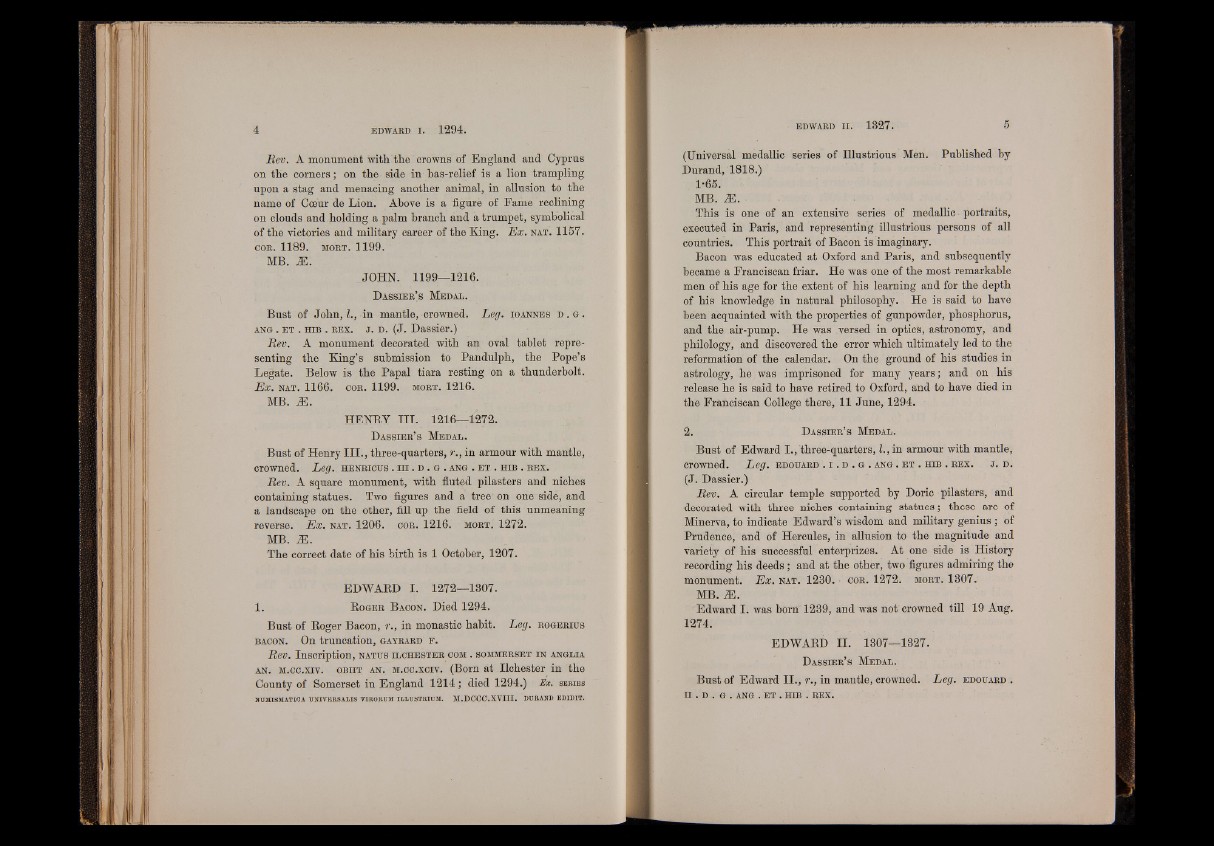
Rev. A monument with the crowns of England and Cyprus
on the corners; on the side in bas-relief is a lion trampling
upon a stag and menacing another animal, in allusion to the
name of Cceur de Lion. Above is a figure of Fame reclining
on clouds and holding a palm branch and a trumpet, symbolical
of the victories and military career of the King. Ex. nat. 1157.
cor. 1189. mort. 1199.
MB. M.
JOHN. 1199—1216.
Dassier’s Medal.
Bust of John, I., in mantle, crowned. Leg. ioannes d . g .
ang . e t . hib . rex. j . d . (J. Dassier.)
Rev. A monument decorated with an oval tablet representing
the King’s submission to Pandulph, the Pope’s
Legate. Below is the Papal tiara resting on a thunderbolt.
Ex. NAT. 1166. cor. 1199. mort. 1216.
MB. M.
HENBY III. 1216—1272.
Dassier’s Medal.
Bust of Henry III., three-quarters, r., in armour with mantle,
crowned. Leg. henricus . h i . d . g . ang . e t . hib . rex.
Rev. A square monument, with fluted pilasters and niches
containing statues. Two figures and a tree on one side, and
a landscape on the other, fill up the field of this unmeaning
reverse. Ex. nat. 1206. cor. 1216. mort. 1272.
MB. M.
The correct date of his birth is 1 October, 1207.
EDWARD I. 1272—1307.
1. Roger Bacon. Died 1294.
Bust of Roger Bacon, r., in monastic habit. Leg. rogerius
bacon. On truncation, gayrard p .
Rev. Inscription, natus ilchester com . sommerset in anglia
an. m.cc.xiv. obht an. M.cc.xciv. (Born at Ilchester in the
County of Somerset in England 1214; died 1294.) Ex. series
NUJHSMATIOA UNIVERSALIS VIRORUM ILLUSTRIUM. M.DCCC.XVIII. DURAND EDIDIT.
(Universal medallic series of Illustrious Men. Published by
Durand, 1818.)
1-65.
MB. M.
This is one of an extensive series of medallic portraits,
executed in Paris, and representing illustrious persons of all
countries. This portrait of Bacon is imaginary.
Bacon was educated at Oxford and Paris, and subsequently
became a Franciscan friar. He was one of the most remarkable
men of his age for the extent of his learning and for the depth
of his knowledge in natural philosophy. He is said to have
been acquainted with the properties of gunpowder, phosphorus,
and the air-pump. He was versed in optics, astronomy, and
philology, and discovered the error which ultimately led to the
reformation of the calendar. On the ground of his studies in
astrology, he was imprisoned for many years; and on his
release he is said to have retired to Oxford, and to have died in
the Franciscan College there, 11 June, 1294.
2. Dassier’s Medal.
Bust of Edward I., three-quarters, I., in armour with mantle,
crowned. Leg. edouard . i . d . g . ang . e t . hib . rex. j . d .
(J. Dassier.)
Rev. A circular temple supported by Doric pilasters, and
decorated with three niches containing statues; these are of
Minerva, to indicate Edward’s wisdom and military genius ; of
Prudence, and of Hercules, in allusion to the magnitude and
variety of his successful enterprizes. At one side is History
recording his deeds; and at the other, two figures admiring the
monument. Ex. nat. 1230. cor. 1272. mort. 1307.
MB. M.
Edward I. was born 1239, and was not crowned till 19 Aug.
1274.
EDWARD II. 1307—1327.
Dassier’s Medal.
Bust of Edward II., r., in mantle, crowned. Leg. e d o u a rd .
I I . D . G . ANG . ET . HIB . REX.